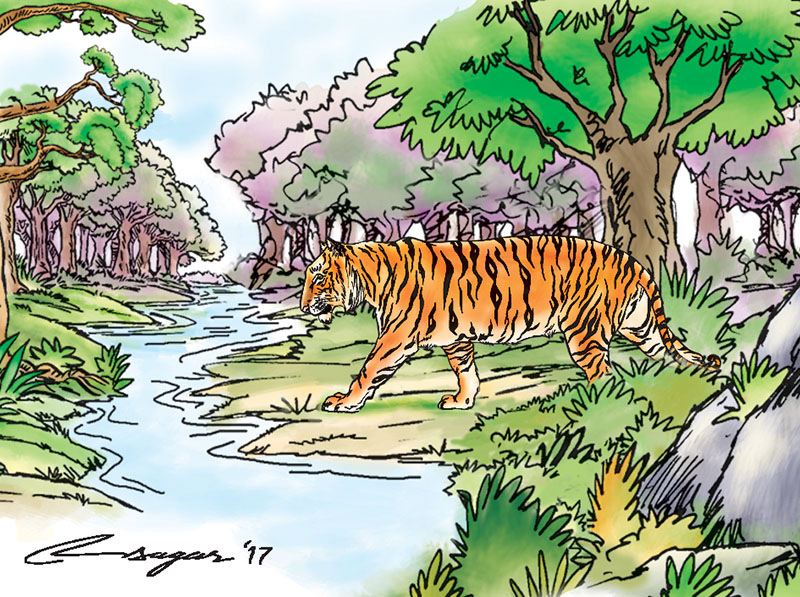Conservation paradox: Addressing concerns
Increasing wildlife numbers in Nepal are something we must be proud about. However, preservation of this success will depend on more of us joining in. By either being a part of the solution, or by not being a part of the problem
Human-wildlife interactions are inevitable in human-dominated landscapes of Nepal. While much of these interactions pass by as plain sightings, some transpire into conflicts, causing losses to people and animals.
Other than individual losses, conflicts can have more severe repercussions, notably reduced tolerance of people and retaliations towards wildlife. Addressing these concerns is critical for sustained success in conservation.
Unfortunately, there are a few choices for conservationists in human-wildlife conflict mitigation. These options are based on two broad strategies. One - keep wildlife away, and the second - keep people safe.
Contemporarily, the first option has taken precedence. Innovations and technology have enhanced our ability to keep animals away from people’s space. An example is solar fencing. WWF is among conservation organizations around the world that have successfully helped people this way, keeping wildlife like elephants away.
A case for this is seen in Madi valley along the Indo-Nepal border in the Terai. Blanketed on all sides by three protected areas - Chitwan National Park and Parsa Wildlife Reserve in Nepal, and Valmiki Tiger Reserve in India -- the valley faced intense conflicts with wildlife.
In 2007/08, under the Terai Arc Landscape – Protected Areas and Buffer Zones (TAL-PA & BZ) project -- helped install a 14 km stretch of solar fence along Madi valley. The outcome was instantaneous. Animals, particularly elephants were safely kept away from people’s farms.
The valley saw nearly 300% increase in the value of crop produced in the first harvest since installation of the fence! WWF Nepal is now experimenting with early warning systems. The theory behind being identification of approaching target animals through sensors that triggers signals to convey information to stakeholders.
These however, are localized solutions designed for intensive conflict settlements. Moreover, these interventions are target-animal specific and not all-encompassing.
A more inclusive approach is being increasingly adopted worldwide. This is the second option– a people-centric approach relying on human intelligence and instincts to keep themselves safe. This is essentially a revival of traditional methods, with modern understanding.
Many forest-dwelling communities even today live harmoniously with wildlife. The principle behind their co-existence is the communities’ understanding of wildlife, rather than keeping animals away. It is one of mutual respect, where wildlife encounters do not normally turn into conflicts, because of the way they respond to these sightings.
Recalling a recent example, for learning, a tiger was shot dead near Parsa WR, last month. News reported that the animal was shot dead, (and rightly so) as it had injured more than ten people. Delving further into the incident reflects on the actual reasons for this ‘conflict’, to help us address these situations better. One news report provided the hint, stating:
“It (the tiger) was first spotted..by a pond. Soon, the villagers gathered, armed with spears, sticks and rocks, to chase the beast...the tiger got agitated when some villagers started throwing rocks while it was hidden among the bushes.” The implications are clear.
The tiger was not there to attack people. It was sitting by a pond. Then it tried to hide. It attacked in self-defense, and was shot dead.
We the people responded wrongly to the sighting; it ended in a tragic conflict where people were unnecessarily injured and a valuable tiger life was lost. There are too many examples of sightings turning into conflicts, because of the way people respond.
The ideal response would have been to leave the tiger alone, without being disturbed or provoked. It would most-likely have gone its way. Wild animals are by nature shy, and avoid people. We need to realize that they are powerful and can be dangerous.
Of course, there are instances when wild animals deliberately attack humans. These outliers, classified as man-killers or man-eaters in case of wild cats, are dangerous to human life. They need to be managed for the well-being of people, and the species.
Human-wildlife relation is complex, and conflict mitigation measures may need to be customized to situations, species, or even individuals. There is no one-solution-fit-all.
We can, and have experienced sightings not turning into conflicts, for instance, wildlife safaris. Few encounters turn into conflicts, when visitors maintain distance, and respect the animals’ space. Our conservation approach is centered around the protected areas system.
The Parsa tiger case is among numerous instances that have raised concerns about safety of people and wildlife outside PAs. Conservation fraternity continues to sensitize public. The general public must also strive to be aware on ‘dos and don’ts’ in such instances.
Nepal is blessed to have a range and diversity in wilderness, from the Terai to the mountain and the species inhabiting these landscapes. In today’s world, increasing wildlife numbers in Nepal are something we must be proud about.
However, preservation of this success will depend on more of us joining in. By either being a part of the solution, or by not being a part of the problem.
Thapa is conservation biologist, WWF Nepal and Shrestha is senior research officer, WWF Nepal






